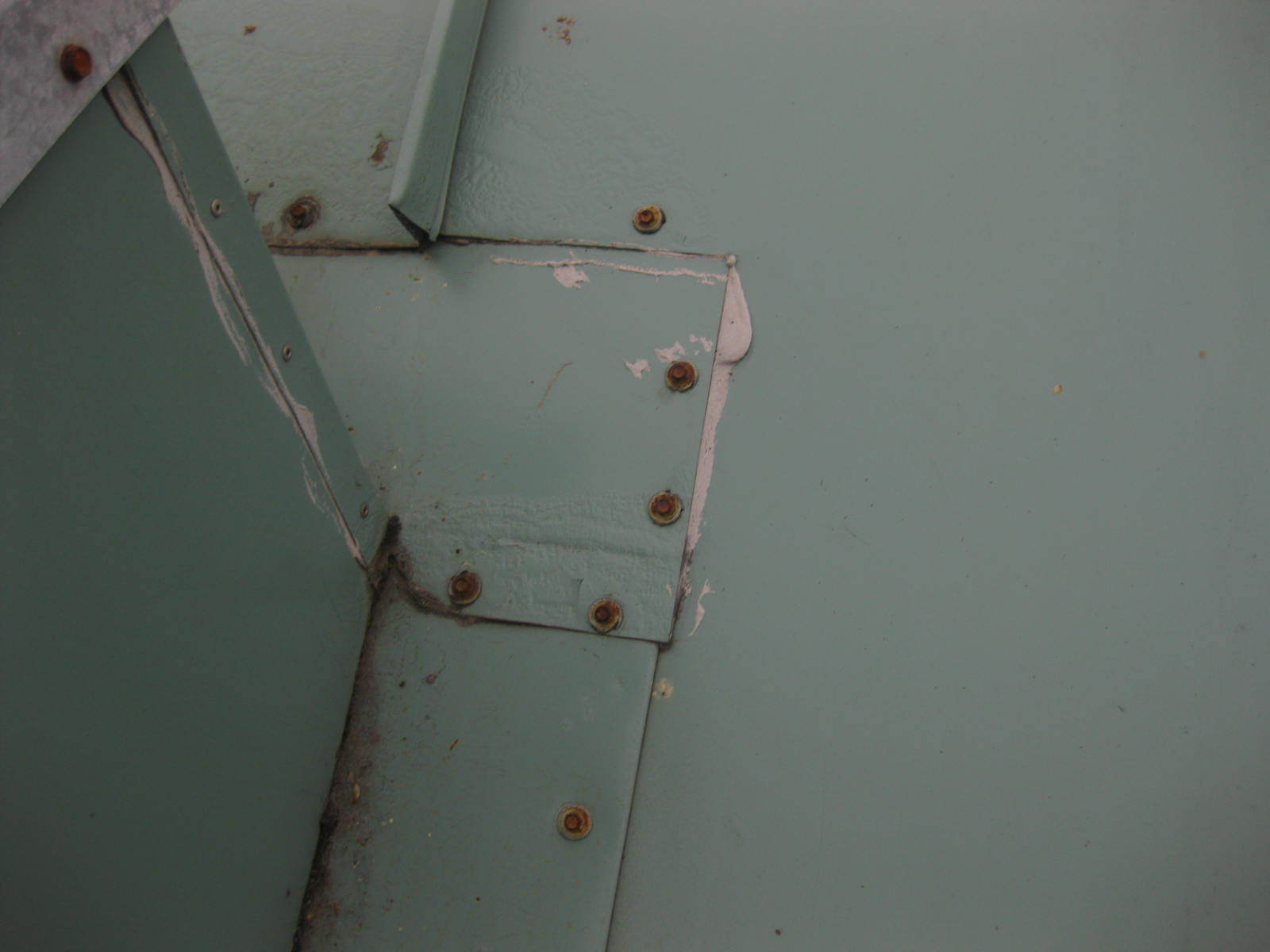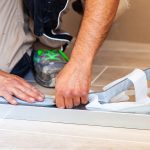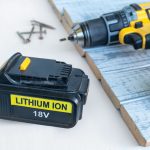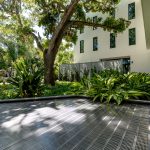Living near the ocean may sound like paradise, but it can be problematic for all building materials. Wind-blown salt spray can be destructive to metal roofing and wall assemblies. Metal is well known for its longevity, but some metals will corrode in coastal environments. Although not all metal roofs and walls corrode at the same rate, over time, salty sea air and humidity will react on them and they will deteriorate. If metal roofs or walls start to rust, they will not function as intended and will have to be replaced. Using the right corrosion-resistant metals and coatings with correct installation techniques can prevent this from happening.
Avoiding corrosion from salty sea spray requires correct metal material selection and installation techniques

This coastal house is protected from corrosion by its aluminum roofing system. (Photo courtesy of Isaiah Industries Inc.)
Plan for Corrosion
One of the first steps to avoid corrosion in a coastal environment occurs in the planning phase. Understand what kind of corrosive environment the structure will be situated in; not all environments are the same. As part of a site investigation, environmental data on corrosion, in addition to contamination, precipitation, humidity and temperature can be obtained from local environmental monitoring stations. The EPA’s website has extensive data covering many different atmospheric attributes for most United States locations.

Corrosion on metal panels at the City College of San Francisco Ocean Campus. (Photo courtesy of IMETCO)

Metal located by the ocean for 10 years shows corrosion. (Photo courtesy of IMETCO)
“Breaking surf proximity and rainfall are important considerations impacting the severity of the coastal environment,” says Michelle Vondran, technical manager at Steelscape, Kalama, Wash. “Breaking surf creates spray and salt laden air and rainfall acts as a rinsing agent that washes salt off metal surfaces. Due to this, the Puget Sound region, with little breaking surf and rainfall of 42 inches is a less severe marine environment compared to the Southern California coast, with its strong breaking surf and less than 12 inches of rain per year. Distance to the coast and the type of coastal environment will typically drive what type of product should be specified. A marine environment is usually defined by a specific distance from salt water. This varies by paint and substrate supplier and can range from 1,000 feet to one mile.”
Panels and Coatings versus Corrosion
Do certain metal panels hold up better than others in coastal environments? Todd Miller, president of Isaiah Industries Inc., Piqua, Ohio, believes, “Aluminum, stainless steel and copper are preferred for coastal environments due to their corrosion resistance. Most metal fabricators will have limits on how close steel should be to a salt or brackish water coasts. If steel must be used in a corrosive environment, I prefer the cut-edge protection offered by the zinc in galvanized steel and would suggest minimum G90 galvanized with a quality paint finish on top of that. The cut-edge protection occurs when zinc ions go into solution with hydrogen from water and then are deposited on the exposed edges of the steel.”

The Queens, N.Y.-based Rockaway Hotel was clad in resilient architectural zinc wall panels due to its proximity to the ocean. (Photo: Jake Ryan, courtesy of B&B Sheet Metal and RHEINZINK)
Charles “Chip” McGowan, president of RHEINZINK America Inc., Woburn, Mass., explains that once installed correctly, “Zinc roofing, wall cladding and façade systems will resist corrosion, air and water infiltration, and withstand high winds. Architectural zinc products’ self-healing, low-maintenance, corrosion-resistant performance have a potential life span of 80 years or more. The resilient performance and natural beauty of zinc has been demonstrated for more than 200 years in marine environments and coastal communities. Natural metals such as zinc perform better than coated materials because they do not rely on an additional coating to protect their substrates. The patina on natural metals in marine environments is usually lighter in color because of chlorides found in the atmosphere.”
Jay Mulligan, San Francisco representative for Cleveland-based The Garland Co. Inc., explains stainless steel clips and fasteners work best when installing aluminum panels in coastal environments. “Clips and fasteners in the roof or wall can rot even though they are not visible. Subframing needs to be stainless steel in an open-joint rainscreen system as well or the framing can rust in the wall and fail.”
Choosing the correct coating system helps minimize corrosion. This includes pretreatments, primers and finish coats. “Chrome pretreatment and chrome primers are preferred for aggressive environments, as they not only offer outstanding adhesion, but they also provide improved corrosion resistance,” says Gary Edgar, national coil and extrusion specification manager for PPG Building Products, Pittsburgh. “High-build primers can also enhance protection by providing more barrier resistance, along with coating both sides of the panel with a more robust system.”

Corrosion on a painted Galvalume parapet trim that collected salt water moisture. (Photo courtesy of Steelscape)
Joe Mellott, president of Innovative Metals Co. Inc. (IMETCO), Norcross, Ga., promotes the use of aluminum with a Coastal Flurothane paint coating in coastal environments. “Premium metals like copper and stainless steel can also be used. When working with stainless steel, be careful to select the correct type. The typical type 304 that is commonly found on the market, will show surface rust. Nobody wants to deal with a building owner who just paid a premium for a stainless steel roof or wall only to find rust spots after a few months. We suggest type 316, 316L (low carbon), or 2205 (high corrosion, high-pit resistance) stainless steel for coastal environments. It is still possible to see surface rust with these types of stainless steel, so it is important to alert the customer.”
Zinc coating, i.e., galvanizing, is a well-developed method of protecting steel from corrosion, and Gary Dallin, PE, president of Steel Technology Services Inc., Burlington, Ontario, Canada, says it does this in two ways. First, it is a barrier providing an impervious layer keeping moisture away from the steel. The second shielding mechanism is zinc’s ability to galvanically protect steel at a cut edge or scratch. Steel is cathodically protected by the sacrificial corrosion of the zinc coating. [Also,] while unpainted galvanized and other metallic coatings on steel sheet provide good, protection from corrosion, the application of high-quality paint can add substantially to the overall life of coated steel sheet products.”
Alana Fossa, senior corrosion engineer, American Galvanizers Association, agrees that a duplex system of paint or powder coating over hot-dip galvanizing (HDG) can significantly extend the coating life of HDG in coastal environments. “The paint or powder coating protects the zinc from initial corrosion while the zinc base layer similarly protects the paint layer from under-film corrosion at scratches and holes. Even for highly corrosive locations such as offshore platforms, painting over hot-dip galvanizing has been known to protect against rust for 10 to 20 years where hot-dip galvanizing or paint alone may have only lasted a few years. Specifiers should be mindful of the use of dissimilar metals when working in coastal marine environments. There are many instances where HDG (zinc) is suitable for long-term use in direct contact with stainless steel or aluminum, but in marine or coastal environments electrical isolation is often recommended to maximize the service life.”

Image provided by Steelscape
Correct Installation
Once the correct corrosion-resistant materials have been chosen, they must be properly stored and installed to meet coastal environment’s requirements. “Proper storage minimizes the opportunity for moisture to become trapped between the protective film and the architectural zinc material,” McGowan says. “The protective film and any adhesive labels should be completely removed as soon as possible after installation to ensure that moisture also is not trapped at the edges of the film.” Edgar says overtightening fasteners can damage the rubber or neoprene washer fracturing a coatings system, thus accelerating the corrosion process.
When metal panels must be cut on a job site, Edgar explains their cut edges should be cleaned with a pretreatment, such as Alodine [commonly known as Chem Film, a chromate conversion coating that protects metals, most typically aluminum, from corrosion] and primer to support adhesion, before being touched-up with an appropriate air dry. Miller explains a rust-inhibiting paint can protect cut edges and that scratches in other areas should also be addressed.
Vondran explains panel edges can be “hemmed” with the exposed edge being folded and tucked underneath so that the edge is not as exposed to environmental elements. “Hemming bends and folds the edge of the metal back upon itself, concealing the edge. Flashing and trim pieces are often hemmed by the product manufacturer and panels hemmed in the field.”

This water wheel in Baltimore was galvanized to prevent corrosion from the marine environment. (Photo courtesy of American Galvanizers Association)
Fossa cites “ASTM A780, Practice for Repair of Damaged and Uncoated Areas of Hot-Dip Galvanized Coatings” as information specific to repair of batch HDG coatings. “It details how to repair a damaged hot-dip galvanized coating including intentional damages performed at the job site. ASTM A780 contains three acceptable methods of touch-up and repair of hot-dip galvanized steel but zinc-rich paint is typically utilized for this purpose. The specification explains how to use the various repair methods as well as the required coating thickness for the repaired area.”
All areas of a metal roof should have natural drainage and avoid having salt water damming at overlaps, ventilators, air control overlaps and other objects. Miller cautions that any flashing design that may trap or hold moisture or salt should be avoided. Richard King, product manager at Steelscape agrees, that metal installations that trap salt water or prevent freshwater rinsing are highly problematic. “This type of design should be avoided or at least easy to rinse with freshwater on a regular basis. In addition, a design that doesn’t allow for drainage or shedding of water will result in corrosion,” King says.
Dallin cautions that roofs with low slopes are subject to the most severe corrosion conditions. “Drip edge puddling is a function of roof slope. The greater the slope, the better the corrosion performance is at drip edges.”
With the right building design, appropriate panel selection, sound installation techniques and robust cleaning and maintenance on the owner’s side, coated metal is an excellent choice for coastal regions. “Reputable panel manufacturers will have technical bulletins available which cover corrosive environments in detail and can assist in ensuring the best possible product is provided,” King says. “Not all suppliers use the same definition for coastal environment, nor do they all require the same paint system. Review warranties carefully for specific product specifications, durations and maintenance requirements.”

Choosing the correct coating system for the intended environment is one of the first steps to avoiding corrosion. This includes the selection of pretreatments, primers and finish coats. (Photo courtesy of PPG)






